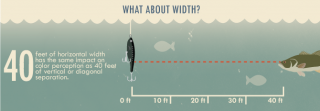Hieronder een artikel over kleuren, en hoe de kleuren het onderwater doen. Mijn mening is niet het zelfde als in het artikel, maar ieder heeft zijn eigen voorkeuren. Bij helder water natuurlijke kleuren, en bij troebel water felle kleuren, is naar mijn mening altijd goed. Zwart, paars, en wit zijn onderschatte kleuren, en moeten vaker gebruikt worden. Bij zonnig weer is goud, zilver, en glitter lak erg goed. redhead is een kleur die op sommige dagen het verschil kan maken, ongeacht de kleur van het water. Zorg dat je genoeg verschillende kleuren bij je hebt, om te kunnen experimenteren.
Dit waren naar mijn mening, enkele belangrijke kleur tips.
Veel plezier met het onderstaande artikel.
View From Below:
Does Lure Color Matter Underwater?
Most keen anglers have a favorite lure or fly color, and swear that their choice will out-perform all other offerings. But just how important is color when it comes to lure and fly selection? Well, according to science, not very important at all!
It's an irrefutable fact that water progressively absorbs or blocks light of different wavelengths, meaning that colors effectively “vanish” one after another as “white” sunlight travels through the water column. The overall intensity or brightness of visible light also diminishes rapidly underwater.

Because this absorption is greater for longer wavelengths (the red end of the spectrum) than for shorter wavelengths (the blue end of the spectrum), perceived colours are rapidly altered with increasing depth or distance through the water.
The precise rate at which this loss of color occurs varies depending on the intensity of the sunlight (whether the sun is directly overhead or low on the horizon, the amount of cloud cover, and so on), as well as the clarity and color of the water itself, and the presence of any suspended matter such as weed or plankton. Even in very clear ocean currents far from shore, less than 25 percent of available sunlight hitting the sea's surface will penetrate much beyond 30 feet or so (10 meters). By the time we reach a depth of 300 feet (90 meters), the remaining light may be as little as 0.5 percent of that available on the surface. In other words, it's a pretty gloomy place down there! In freshwater lakes and rivers, this loss of light with depth is even more dramatic.

As already mentioned, red is the first color visible to our eyes to disappear, and is typically gone within 15 or 20 feet (5 - 6 meters) of the surface (much less in turbid water). Orange disappears next, then yellow, green, and purple. Blues (both the tones of blue visible to our human eyes and also the shorter, ultra-violet wavelength many fish can see) penetrate deepest of all.
This phenomenon has a profound impact on the way things look to us (and presumably also to fish) underwater. White objects will appear bluish or gray underwater, and the darkness of that blue/gray appearance increases rapidly with depth. Red objects will begin to look dark brown or even black within a few meters of the surface. Down at 40 or 50 feet (15 meters), even in very clear water, the world appears to be composed entirely of shades of gray, blue, and black.

It's worth stressing that this loss or alteration of visible colors occurs in both the vertical and the horizontal or diagonal planes. So, 40 feet of vertical depth has roughly the same impact on light waves and color perception as 40 feet of horizontal or diagonal separation between object and observer. In other words, a red lure may look black when viewed at a depth of 40 feet, but it will also appear black, or at the least brown or very dark grey, when viewed from the side at a distance of 40 feet, even if it's traveling right up in the surface layer.

At face value, this phenomenon of light and color loss underwater makes a complete mockery of the importance of color in lures anywhere beyond shallow, ultra-clear scenarios, yet anglers the world over will continue to argue that one color is better than another, even in deep-water jigging. The funny thing is, if you ask half a dozen fishers for their opinion on the most effective lure color, you're likely to receive six different answers. Perhaps it's time we moved color to the bottom of the list of criteria when choosing a lure or fly, and placed far greater emphasis on the size, action, profile, and speed of our offerings.